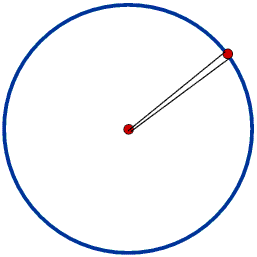
We often talk about the Earth going round the Sun in a circle, but in fact it goes round the Sun in an ellipse.
If we take a short piece of string and pin the two ends together on a board and put a pencil through the loop we can draw a circle. The pin is at the centre of the circle.

If however we pin the ends of the string to different points we draw not a circle but an ellipse. The two pins are at the foci of the ellipse.
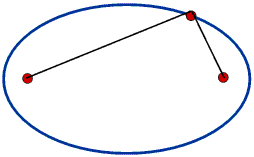
An ellipse is a special type of oval. Its shape depends upon how far the foci are apart - the further apart they are the greater its eccentricity.
If the foci are at the ends of the string we have a straight line.
The Earth goes round the Sun in an ellipse with the Sun at one focus (not in the middle), and so do all the other planets.
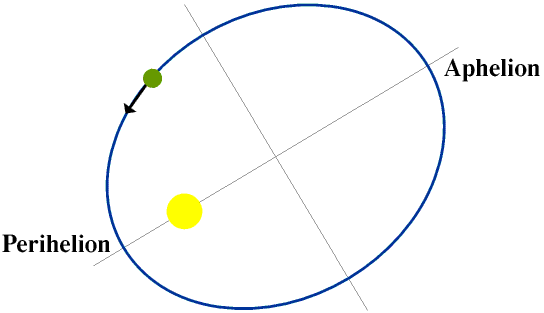
Newton's Laws of Motion and Theory of Gravity can be used to show that the speed of one body in orbit round another body depends upon the distance between them. So as the Earth approaches perihelion it gets faster; its speed is greatest at perihelion and least at aphelion.
All the planets have quite low eccentricities: for example the Earth has an eccentricity of 0.017, a perihelion of 147.1 million kilometres, an aphelion of 152.2 million kilometres and a mean distance from the Sun of 149.6 million kilometres. To a first approximation we usually take the Earth to be in a circular orbit at a distance of 150 million kilometres from the Sun.
The orbital data for all the planets can be found on many web sites - to visit one very good one please click here ![]()
The orbit of Pluto is much more eccentric, but Pluto was removed from the list of planets in August 2006 for reasons discussed on the Planets Page of my Web Site.
The sheer size of the solar system is unimaginable - you can get some idea of it by making a model; for the instructions please click here ![]()
If we make a scale drawing of the orbits of the planets on a sheet of A3 paper, the orbits of all the planets are so nearly circular that on this scale the difference between their orbits and a true circle is never more than 0.5 mm - mind you, on this scale the orbit of Neptune is 500 mm across while the orbit of Mercury is only 6 mm across. So we usually show the orbits of all the planets as circles; if we want to discuss some of the effects of an eccentric orbit (as we do in the next section) we must greatly exaggerate it.
The Earth is spinning on its axis: this gives us day and night. The time taken for the Earth to spin on its axis is about 24 hours - hence there are 24 hours in a day. When we say “The days are longer in the summer than the winter” we are using the word day to mean something quite different - fortunately most of us understand this without having to think about it.
The Earth is also moving in orbit round the Sun: it is this which gives us the Seasons of Spring, Summer, Autumn and Winter. The time taken for the Earth to orbit the Sun once is about 365 days - hence there are 365 days in an ordinary (common) year.
The Sun is a star, like millions upon millions of other stars, but is special to us because it is only about 150 million kilometres away from us. All the other stars are unimaginably far away: they are so far away that we can consider them to be fixed in space.
As the Earth spins on its axis the Sun appears to move across the sky. It rises in the East and sets in the West and in the middle of the day it is at its highest point in the sky. In England and all other places between the Tropic of Cancer and the Arctic Circle when it is at its highest point in the sky it is due South. If we want to measure the length of the day we cannot start measuring it from Sunrise or Sunset because these change with the seasons, instead we usually start measuring it from the time at which the Sun is at its highest point in the sky and due South, that is, when it crosses the meridian. Hence of course a.m for ante meridian and p.m. for post meridian. (Meridian can be spelled other ways but all the spellings come from the Latin medidiem which just means the middle of the day. This is further discussed on the Solar Day Page of my Web Site.)
The diagram shows the Earth's orbit round the Sun. Point P1 is close to perihelion. We have two telescopes: we set up telescope A to point at a certain star, and telescope B to point at the Sun at midday.
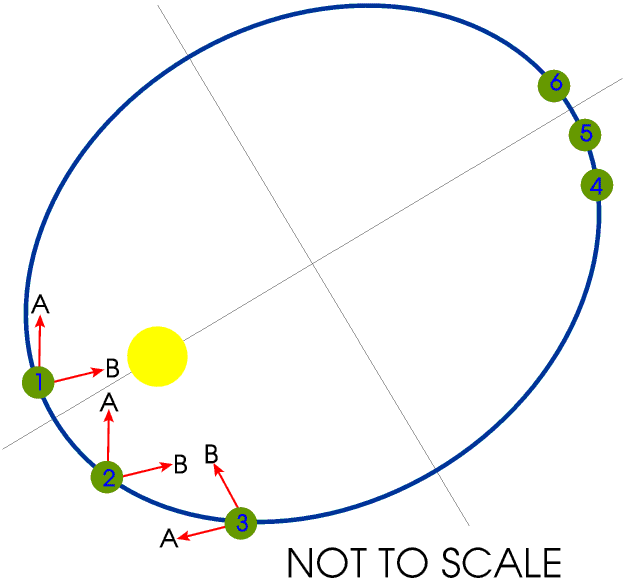
The Earth now makes one revolution - at the end of this revolution A will be pointing at its star again, but during the time the Earth took to make one revolution it has also moved round the Sun to position P2, and now B is not pointing to the Sun at midday.
It has to move to position P3 before B is pointing to the Sun at midday, but now A is no longer pointing at its star. If we take the length of the day as the time taken for B to return to pointing at the Sun at midday then this is longer than the time taken for the Earth to rotate on its axis. The time taken for the Earth to to rotate on its axis is actually 23 hours 56 minutes 4.09 seconds, although it is usually given as about 23 hours 56 minutes. This is a sidereal day (from the Latin sidus, a constellation), because after a sidereal day any point on the Earth has returned to the same place relative to the stars. The time taken for B to return to pointing at the Sun at midday is called a true solar day, (from the Latin sol for Sun).
Because the Earth's orbit is not circular but elliptical, at perihelion it is moving faster round the Sun than at aphelion. P4, P5 and P6 are the positions corresponding to P1, P2 and P3 at aphelion. As the length of a sidereal day is constant, at about 23 hours 56 minutes, it can be seen that the length of a true solar day is greater when the Earth is near perihelion than when it is near aphelion. There are also other reasons why the length of the true solar day varies. So when we say “There are twenty four hours in a day” this is the mean length of the solar day averaged over a whole year. Twenty four hours is the length of a mean solar day, hence the mean in Greenwich Mean Time.
Sundials always show 12 noon when the Sun is due South, so they always tell true solar time. The difference between true solar time and mean solar time is given by The Equation of Time, and can be up to 16 minutes. For more information about The Equation of Time and to see it displayed as a graph you can visit the National Maritime Museum web site - to do so please click here ![]()
The Earth is rotating on its axis at about one degree every four minutes, so there will be a solar time difference of about four minutes between two places one degree of longitude apart - this difference is the same whether we are using true or mean solar time. Bath is about two degrees twenty minutes due West of London so Sundial time in Bath is about nine minutes behind that in London. In the Middle Ages, when for most people the only way to get to the next village was to walk, every village kept its own time. So when Stage Coaches began to operate a scheduled service between London and Bath, in the eighteenth century, they were fitted with special clocks which could be set to lose nine minutes on the journey from London to Bath, and then gain nine minutes on the return journey. But when the Railways came, during the early years of the nineteenth century, this sort of arrangement was quite impractical, so the Railways, and eventually the whole country, used London (Greenwich) time. Today the whole world is divided into a number of time zones, where all the clocks in the same time zone are set to the same time. Britain and Ireland and Portugal are in the Greenwich Mean Time zone, while France and Germany and most of the rest of Europe are in the Central European Time zone, which is one hour ahead. Some countries such as the United States of America are in several time zones. To visit a web site showing the world's time zones please click here ![]() This means that the difference between Sundial Time and Clock Time depends not only on The Equation of Time but also on your position East or West within your Time Zone.
This means that the difference between Sundial Time and Clock Time depends not only on The Equation of Time but also on your position East or West within your Time Zone.
The Earth's axis is tilted: this is what gives us the seasons. The Winter Solstice occurs when the Sun is above the Tropic of Capricorn - this is about December 22nd, and in most years December 22nd has the fewest hours of daylight (in the Northern Hemisphere), which is why it is called Midwinter's Day. The seasons are more fully discussed on another Page of this Web Site.
Our word solstice comes from an Anglo-Saxon word and means standing still: at the time of the Solstice the length of the day seems to be standing still.
Here are the times, in Greenwich Mean Time, for Sunrise and Sunset and the length of the day for London for December 22nd 2004 and the days on each side of it. They are taken from the Sunrise and Sunset Web Site which gives the times of Sunrise and Sunset for any place and any date - to visit it please click here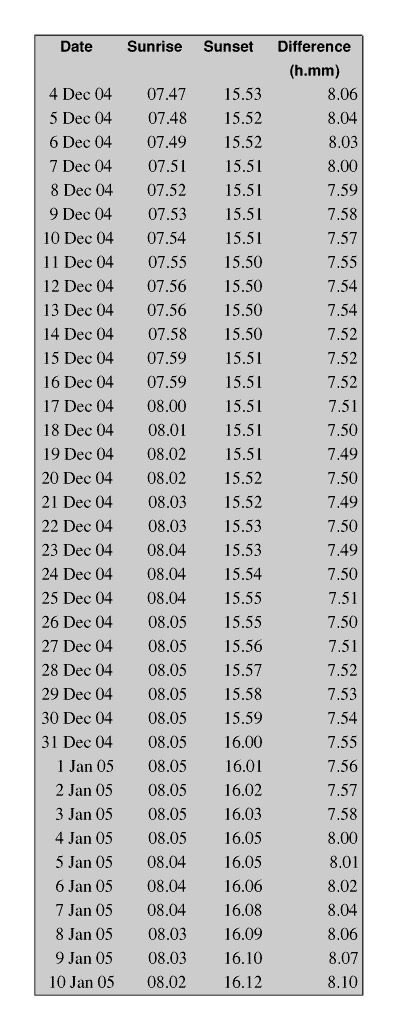
Until about 17th December the days are getting shorter, then for about ten days they are all within about a minute of the same length, then from about 27th December they start getting longer again. The times of sunrise and sunset used have been rounded to the nearest minute so the difference between them can be up to a minute in error: this is why the times given for the days from 17th December to 27th December seem to vary between 7 hour and 49 minutes and 7 hours and 51 minutes. In 2004 the actual shortest day, to the nearest second, was December 22nd.
It seems from this Table that the mornings go on getting darker until about January 4th, while the evenings start getting lighter from about December 15th. But this is because, at the moment and by coincidence, at the time of the winter solstice the Earth is very close to perihelion, so from the Equation of Time the difference between true solar time and mean solar time is changing very rapidly. If we use true solar time we find that the shortest day does have the latest sunrise and the earliest sunset.
Here is a graph of the length of the day against the number of days from the Spring Equinox for a place where there are eight hours of daylight on the Winter Solstice.
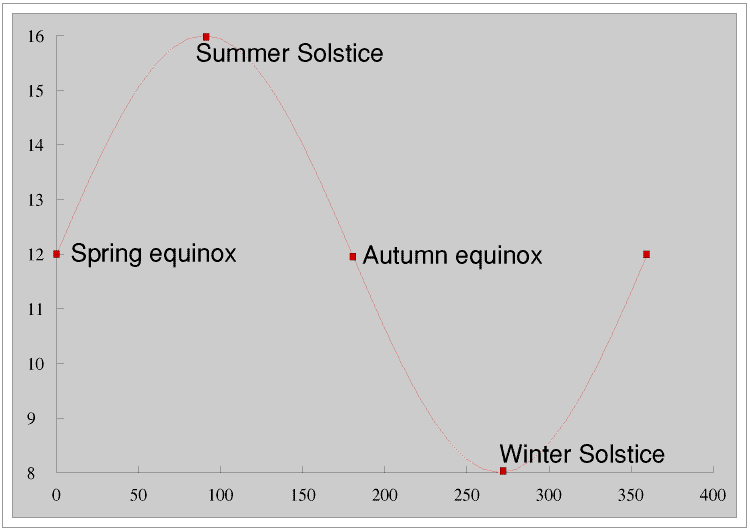
This shows the standing still of the length of the day at the solstices in graphical form.
The seasons are caused only by the tilt of the Earth on its axis; perihelion and the eccentricity of the Earth's orbit have nothing at all to do with them. In 2005 perihelion was on January 2nd but, because of precession (see next Paragraph), the date of perihelion changes by about two days every hundred years, so when the Pyramids of Ancient Egypt were being built perihelion was occurring at about the time of the September equinox.
This and a number of other matters including precession are discussed on another website. This website is quite technical and well beyond even A Level standard, but if you do want to link to it please click here ![]()